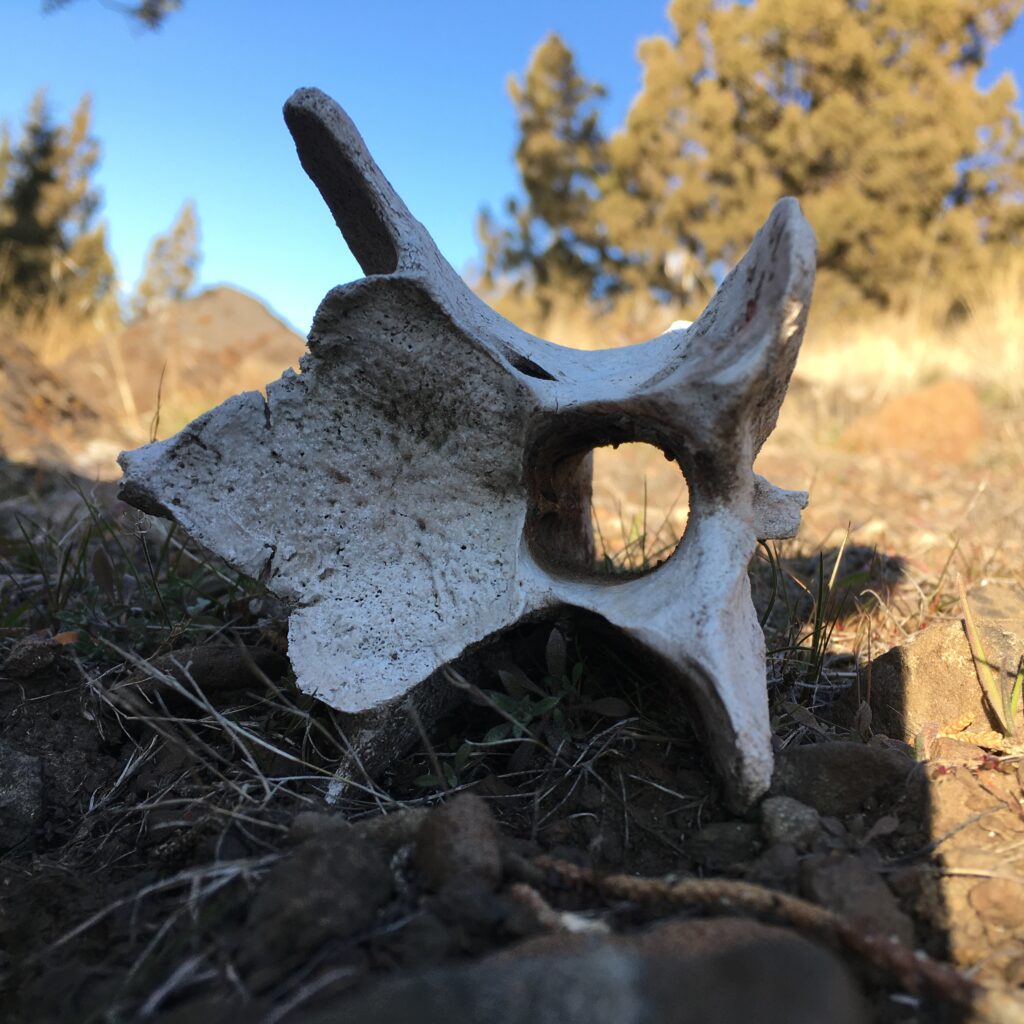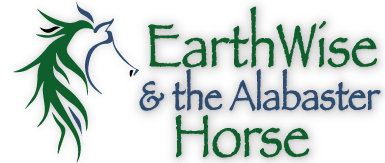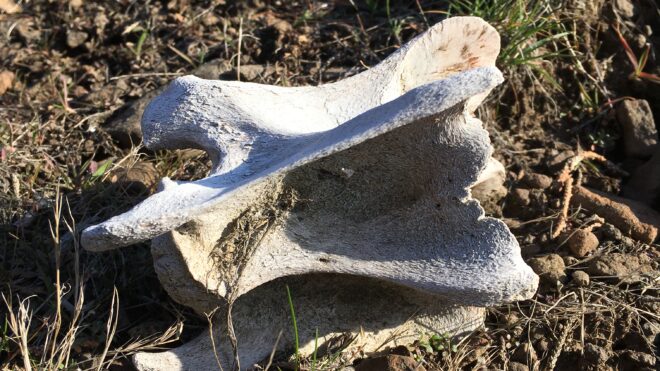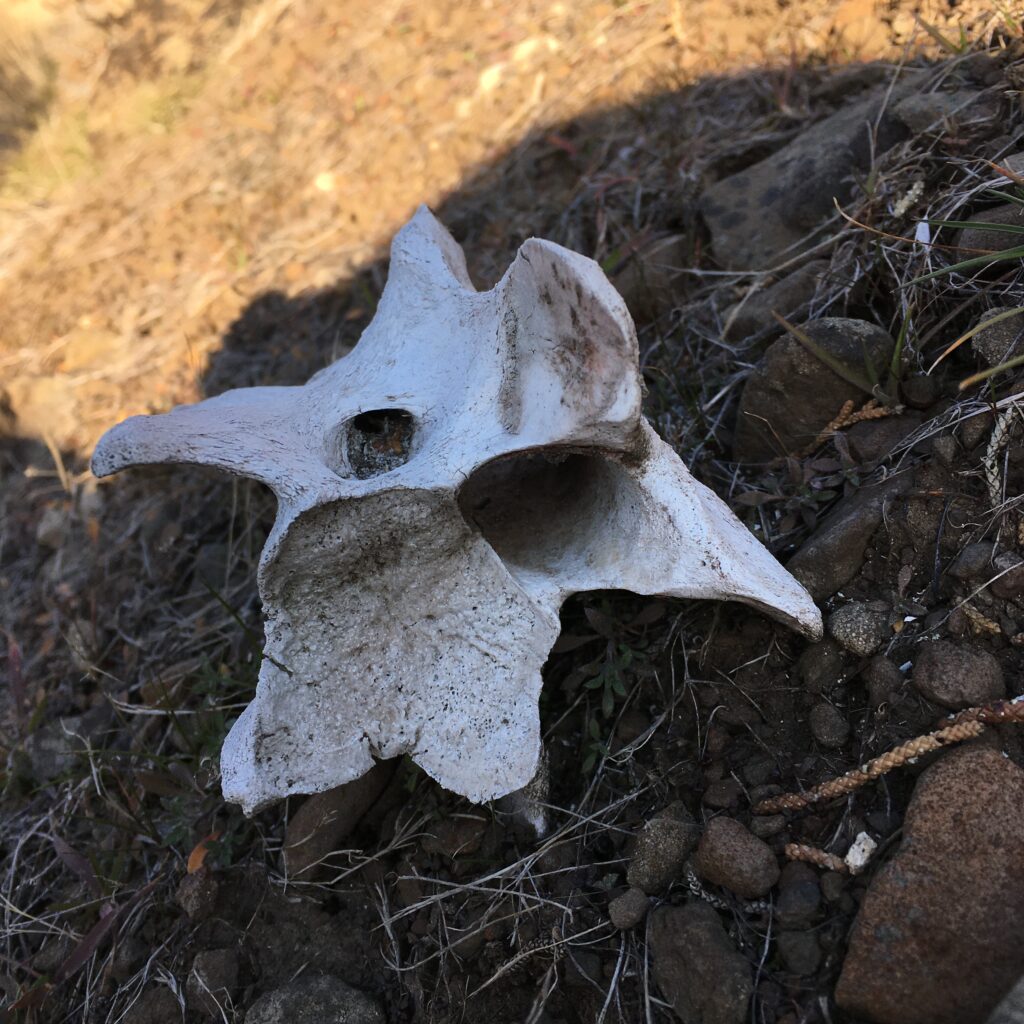It took me by surprise. Resting on the steep backside of a ridge whose top was ringed with a black rock outcropping that gave it the feel of a fortress, the white bone snapped into view just before my foot landed on it. Whoa! I managed to redirect my footfall. Not only to avoid hurting the bone, but also to keep it from rolling under my foot and sending me on a tumble down the hillside.
I’ve seen plenty of bones in my life. In a life lived amongst livestock, you get familiar with death and bones. You also get familiar with the always-incredible, yes miracle, of new life. But bones have always intrigued me. You see them, and you wonder, “How did that cow die?”, or “What color was that horse?”, or “I wonder how this jumble of deer bones came to land in the bottom of this draw?”, or “I am damn glad there is no longer a snake in this sinuous snake-y skeleton!” Things like that. Bones beg questions. They also beg observation.
After not stepping on the bone on the hillside, I turned to look at it. It was a vertebrae bone. I could not have said what species it came from, and it did not matter, really. Given the ridge I hiked that sunny February afternoon in central Oregon was on grazing land, it had most likely formerly resided in a cow. It shone there all alone and rested on its bed of grass and small stones. It did not seem lonesome. It was a bone who knew its power and did not require any uplifting from outside sources, except the earth it reclined upon.
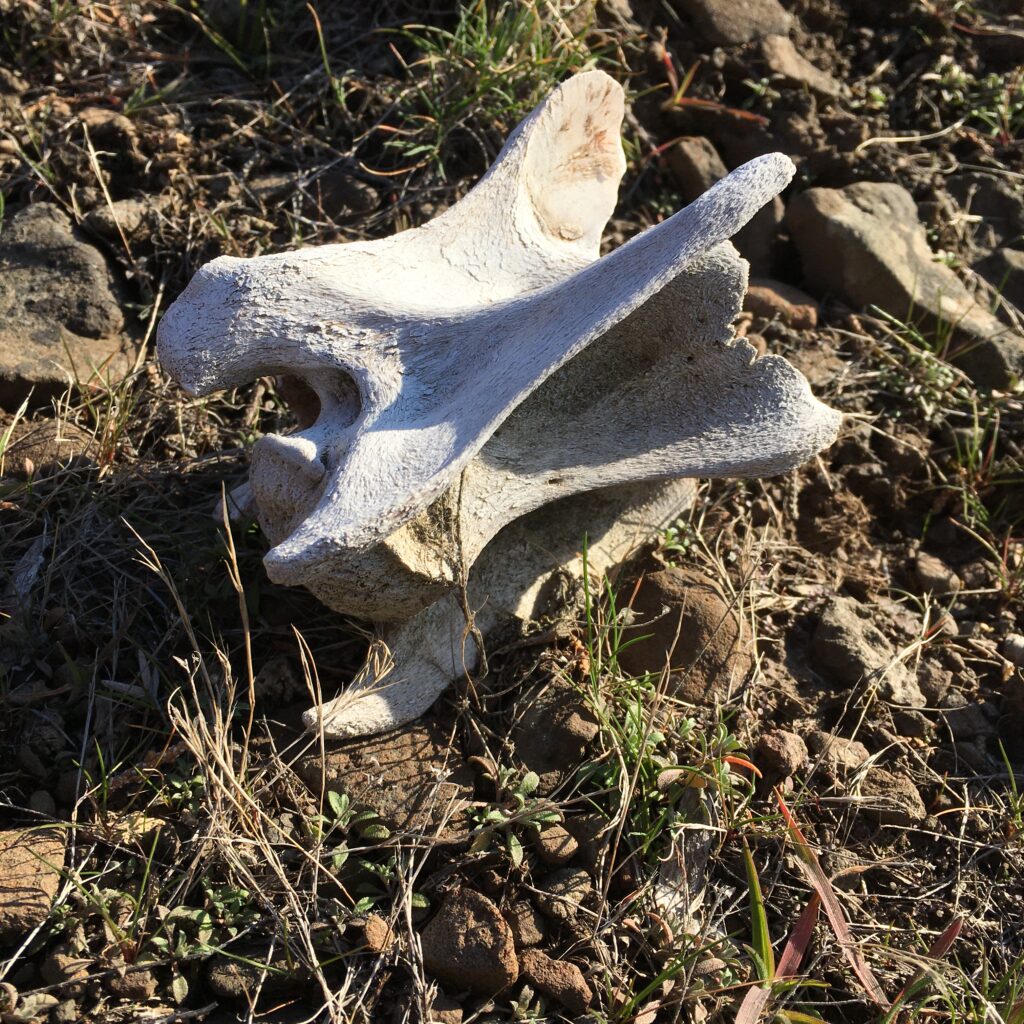
I knelt down and got a better look at it. It had been naked for some time. Its surface was roughened and bleached. New bones are smooth and tan-ish. One of its protuberances had broken off. Dust had blown into crevices and hollows. There were no chew marks to be seen. Coyotes and foxes, even porcupines, will gnaw on bones. They scatter them out, too. Which is probably how this cuboidal bone came to be by itself, though it gave no evidence of teeth marks. Maybe an eagle had picked it up in its talons, then dropped it from the heights it soared on. Or a coyote pup may have packed it along one moonlit night as it lagged behind its mom and siblings. Just like puppies, they will carry “treasures” in their mouths. On finding itself falling behind, the pup would have dropped the bone and galloped to catch up. There were no tiny teeth marks on the bone, either.
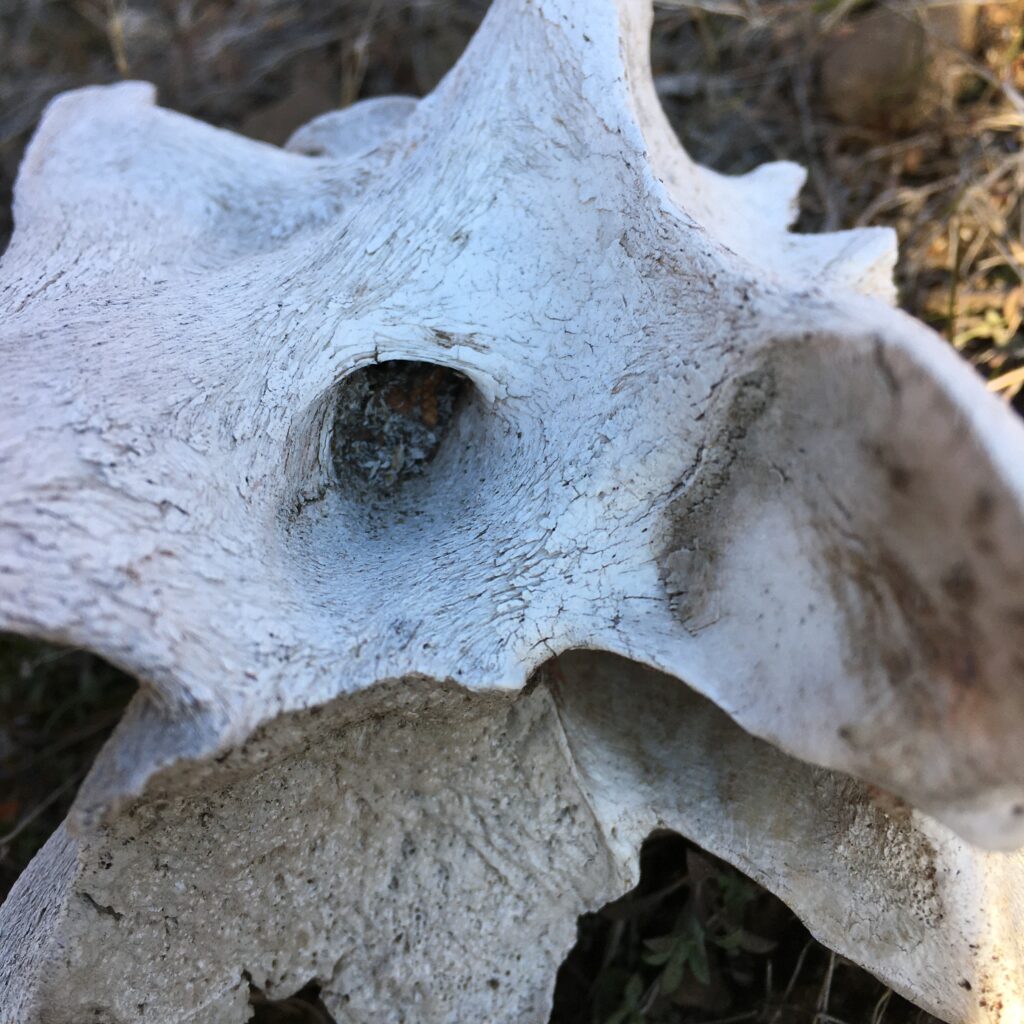
Most ranches will have a bone pile. When livestock die, especially in inconvenient places like the road or a gateway, they are placed in an out of the way area that comes to be called The Bone Pile. For a time as the animal decomposes, coyotes and magpies, eagles, dogs and even cats will hang around The Bone Pile. Ranch kids also are drawn to bone piles. They like to poke through them. They will heft a femur and ask their Dad or Mom something like, “Do you think this belonged to the crazy cow that broke her front leg?” Ranch kids grow up close to such things.
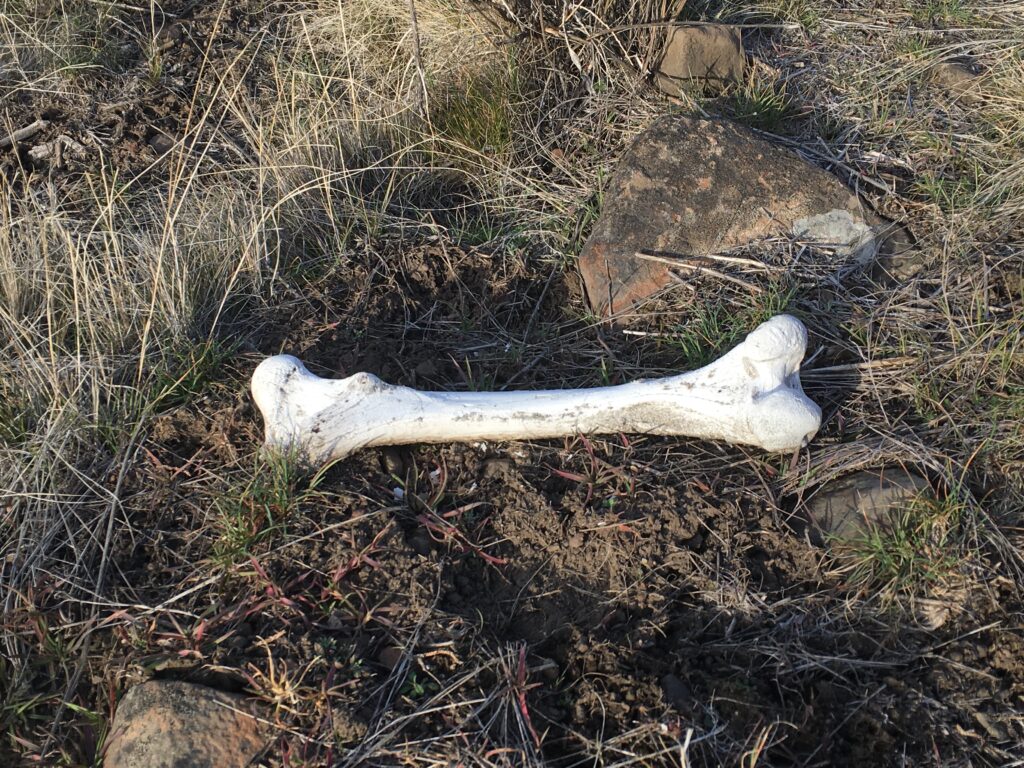
As I crawled around the bone on the hillside, it was like a trek around a formation of the earth itself. Which it really was. The bone had knife-edge ridges which swooped down to the hollow of a valley, before a rise climbed again to another ridge top. It had geographical features that dropped off into space. An errant step off of one of these, and splat! onto the rocks below. There were caves to hide in, and steep cliffs that could only be scaled with ropes. Ski slopes to satisfy skiers of all abilities adorned the bone. I spied an especially gentle slope that fell to an enticing plain for my cross country skis to glide over. And over there, around that corner, was a plain to gallop over with my horse. I felt the wind caress my face and the thud of hooves. Oh, but what a hike it would be, to stride over hill and dale of rough white ground. Different, to be sure. What would it be like, to walk over this surreal landscape? Nothing like the moon, I was certain. Though to us here on earth the moon appeared vanilla white, was it really? I loved the moon and the silver light it shed over the land. To go to it, I have never had the slightest desire. But the boney landscape before my eyes? It implored me to explore.
Cheek pressed to the earth, I gazed through the tunnel that traveled the length of the bone’s center axis. Bones are organic and were once alive. Here was a once-living tunnel. I thought of the tall, green, arched tunnels that quivered and whispered of the aspen groves I was besotted with. This tunnel was similar, though it did not whisper in the way aspen groves do. Its language was smooth and teetered on the point of inaudible. My mind scrambled into the tunnel.
Its inner surface was smoother than the outer. There were a few rough patches, but not too many. Not enough to cause me to duck my head. Sometime in the past, a spinal cord had occupied this space. It carried impulses from the brain of the animal to the rest of its body. Now, I was the living impulse moving through the tunnel. My mind was greedy in its need to reach that far end of the tunnel, where the sunlight shone. But wait, I told it. Listen. This tunnel has memories of its animal impulses. My feet paused, though my mind strained forward. My heart admonished my mind, “stay your journey.” So my feet stopped. In the silence in that tunnel, I felt electric echoes of animal impulses. Sunlight rich and warm on a red cow’s hide. Cool, wet muzzle of her calf at her flank. Sweet taste of green bunch grass. Lazy switch of her white tasseled tail at the fly who buzzed at her back. Far distant hills in her gaze. Just ahead, the lowing of her herd as they moved to mid-day water. Springy grass and gritty gravel under her cloven feet. Fresh west spring breeze ruffles the thick, curly hair of her forehead as she faces into it. The frigid bite of a January blizzard.
I was lost. Even though the tunnel was straight and short, the memory of the impulses held me hostage. They told of the life of this red cow. They washed over me, one after the other. I staggered under the weight of their intensity. To live this close to life would be intoxicating.
Then there was the last impulse. The deep breath that sighed out, one last heave of the great ribcage. The final twist and thump of the heart. The terminal weak and tiny impulse down the spinal cord. A life concluded.
At some point, my feet had recommenced our journey through this tunnel. We reached the sunlit opening at the end. Before us, a first sprig of green grass stretched upwards. I grasped it. Its upwelling of life rushed into me as I squeezed out through the tunnel’s far opening. The west breeze ruffled my hair and the late afternoon sun warmed my face. My mind, released now from the potency of the impulses, fragmented into a thousand shards. As I raced to gather them before they disappeared into oblivion, I wondered. Could I live so intoxicated with life?
